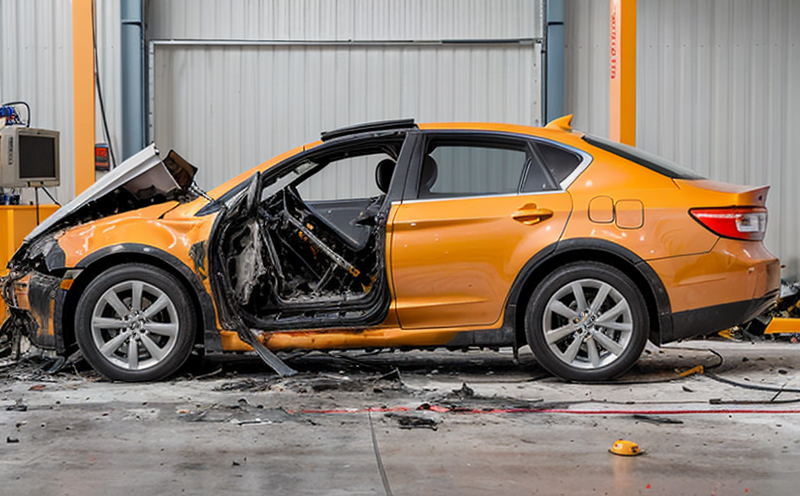IEC 63115 Mechanical Abuse and Crash Testing of Stationary Lithium Batteries
The International Electrotechnical Commission (IEC) standard IEC 63115 is designed to ensure the mechanical integrity and safety of stationary lithium batteries used in various applications. This testing protocol focuses on simulating real-world scenarios where a battery might be subjected to mechanical stress or impact, such as falls, drops, or crashes. The primary goal of this test is to evaluate how well the battery can withstand these conditions without compromising its performance or posing a safety hazard.
Stationary lithium batteries are critical components in modern infrastructure systems including energy storage systems (ESS), uninterruptible power supplies (UPS), and backup power sources for data centers. Ensuring that these batteries meet stringent mechanical abuse requirements is essential to prevent potential failures, fires, or other hazards during installation or operation.
The test procedure outlined in IEC 63115 includes several stages aimed at assessing the battery's resilience against different types of mechanical stress:
- Drop Test: The battery is dropped from a specified height onto a steel plate. This simulates accidental drops that may occur during handling or installation.
- Vibration Test: The battery undergoes controlled vibration to replicate the effects of transportation and harsh environmental conditions.
- Thermal Shock Test: Temperature cycling is applied to simulate rapid changes in ambient temperature, which can affect battery performance over time.
- Pressure Test: External pressure is applied to evaluate whether the battery can withstand physical compression without failure.
- Collapse Test: The battery is placed under a heavy weight to determine its ability to maintain structural integrity during severe mechanical stress.
During specimen preparation, each lithium battery undergoes thorough inspection and documentation. This includes assessing the battery's nominal capacity, voltage, and other relevant specifications before it can be subjected to testing. The test setup involves specialized equipment capable of simulating real-world abuse conditions accurately. For instance, drop tests use calibrated platforms and measurement devices to ensure consistent results.
The acceptance criteria for IEC 63115 are stringent and based on international standards. A battery passes the mechanical abuse test if it remains operational after all specified abuse conditions have been applied. If any part of the battery fails during testing, such as leakage or catastrophic failure, it is considered non-compliant with this standard.
By adhering to IEC 63115, manufacturers and suppliers can demonstrate their commitment to quality and safety in stationary lithium batteries. This compliance also provides an opportunity for companies to showcase their products' robustness against potential mechanical stressors, thereby enhancing market confidence and trust.
Quality and Reliability Assurance
The process of IEC 63115 testing is crucial in ensuring the quality and reliability of stationary lithium batteries. This testing not only evaluates the physical integrity of the battery but also provides insights into its operational characteristics under abusive conditions. The results from these tests can be used to refine manufacturing processes, improve design, and enhance overall product performance.
Quality managers and compliance officers rely on IEC 63115 as a benchmark for meeting regulatory requirements and industry expectations. By incorporating this test into their quality assurance protocols, companies can ensure that their products are not only reliable but also safe to use in various environments.
R&D engineers benefit significantly from the insights gained through mechanical abuse testing. They can identify areas where improvements are needed and implement changes that enhance durability and safety. This iterative process helps in developing batteries that meet both current standards and future needs, making them more competitive in an ever-evolving market.
For procurement teams, ensuring compliance with IEC 63115 is essential for selecting suppliers who prioritize quality and reliability. By specifying this standard as a requirement in their supplier contracts, organizations can ensure that they are working with partners committed to producing high-quality products.
Frequently Asked Questions
Competitive Advantage and Market Impact
Compliance with IEC 63115 offers several competitive advantages in the market:
- Enhanced Safety Perception: Demonstrating compliance with a globally recognized standard can significantly enhance customer confidence, leading to increased sales and market share.
- Innovation Leadership: Engaging in rigorous testing helps companies stay ahead of regulatory changes and industry trends, fostering innovation.
- Cost Efficiency: By identifying potential issues early in the development process, companies can avoid costly recalls and repairs later on.
- Better Brand Reputation: A strong compliance record contributes to a positive brand image, attracting both consumers and business partners alike.
These advantages collectively contribute to greater market competitiveness and long-term sustainability for battery manufacturers and suppliers.
Use Cases and Application Examples
The results from IEC 63115 testing can be applied in various use cases:
Data Centers: Ensuring that backup power supplies are capable of withstanding mechanical stress is crucial for maintaining uninterrupted service during emergencies.
Offshore Oil and Gas Platforms: In remote locations, the reliability of stationary lithium batteries used in emergency power systems cannot be overstated. IEC 63115 testing helps ensure these batteries can perform reliably under harsh conditions.
Telecommunications Infrastructure: For backup power solutions in telecommunications networks, compliance with this standard guarantees that batteries remain operational during critical periods.
Critical Medical Facilities: In environments where uninterrupted power is vital, such as hospitals and clinics, the robustness of stationary lithium batteries is a key concern. IEC 63115 testing ensures these batteries can withstand any mechanical abuse they might encounter.





